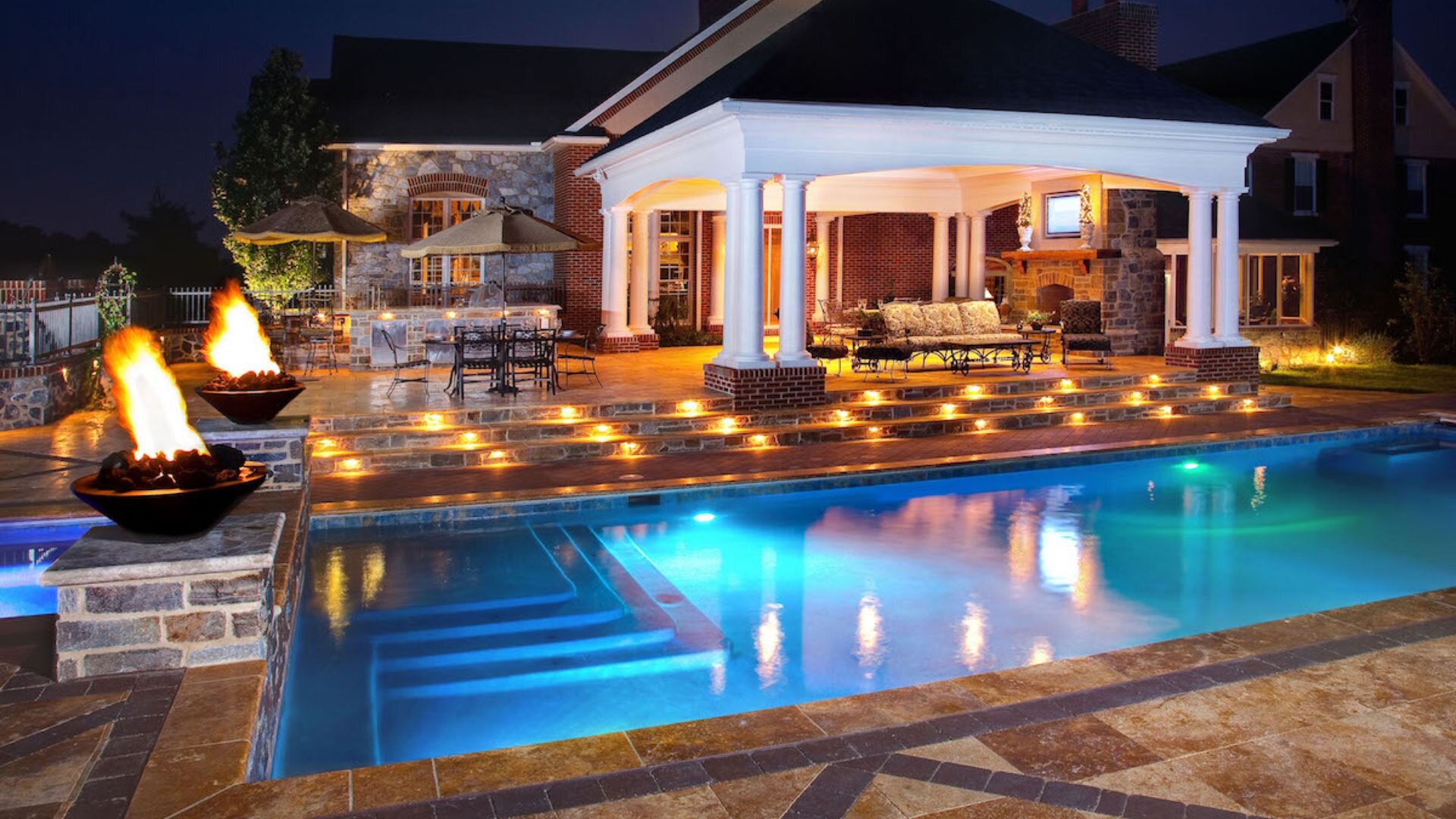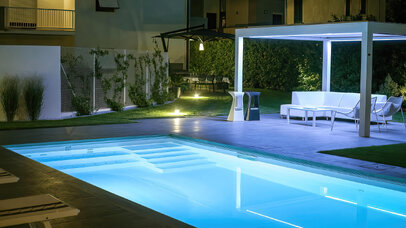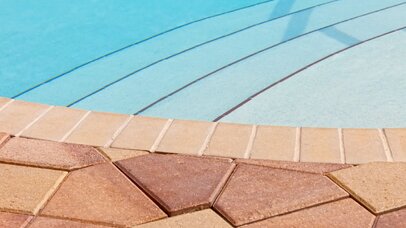Diving into the serene ambience of a well-lit pool area can turn any ordinary backyard into a stunning retreat once the sun sets. Incorporating lighting into your pool paver design is not just an aesthetic choice—it’s a practical one that extends the joy of your outdoor space into the evening hours.
This guide is crafted to help you navigate through the selection of pavers, choosing the right lighting, and the intricacies of installation, ensuring that your poolside is as functional as it is enchanting. Let’s illuminate the steps to achieving a beautifully lit pool that beckons you to enjoy every moment, day or night.
Understanding the Basics of Pool Paver Design
When designing a poolside, selecting the right pavers is as crucial as choosing the pool itself. Pool pavers come in various materials, such as concrete, brick, and natural stone, each with its own set of characteristics.
Concrete pavers offer versatility and a wide range of colours and finishes. Brick provides a traditional look and is known for its durability and slip resistance. Natural stone pavers, such as travertine, slate, or limestone, offer unique patterns and textures, adding an upscale touch to the pool surrounds.
Before settling on a type of paver, consider factors like durability, safety, and harmony with the pool’s design. Slip resistance is essential for pool pavers due to the wet environment. Additionally, the colour and texture of the pavers should complement both the pool and the surrounding landscape to create a cohesive outdoor living space.
Lighting Types and Techniques
Choosing the right type of lighting can enhance the functionality and beauty of your pool area. LEDs are energy-efficient and have a long lifespan, making them an ideal choice for poolside lighting.
Solar lights are eco-friendly and can be easily installed without wiring, but their output may vary depending on the weather. Fibre optic lighting is another safe option around water and can create stunning visual effects.
In terms of techniques, uplighting can emphasise texture and features such as trees or sculptures, while downlighting can mimic natural moonlight and provide general illumination. Accent lighting highlights specific areas or features, and safety lighting ensures that steps, edges, and walkways are visible and safe to navigate after dark.
Planning Your Lighting Design
To start planning your lighting design, first take stock of your pool area during the day and at night. Identify features you’d like to highlight, such as plants, architectural elements, or water features. Consider the balance of light and dark areas to ensure that the space is well-lit without being overwhelming.
Creating a cohesive look involves considering the style and colour of your existing outdoor lighting and ensuring new additions complement them. Also, think about how the lights will look inside your home and from different angles in your garden. The goal is to transition between the pool area and other outdoor spaces seamlessly.
Incorporating Lighting into Pavers

Planning Paver Lighting Placement
To plan lighting placement, consider where lights along pool edges or steps will provide optimal safety. Locations should also be chosen within the pool deck or on raised patio areas for ambient lighting. Before installation, symmetrical or random designs can be sketched out.
Selecting Durable Light Fixtures
Light fixtures chosen should be rated for outdoor and wet locations near pools to withstand the environment. They must also endure foot traffic from those in the area. LED options offer long-lasting bright light while staying cool to the touch.
Preparing the Pavers
Concrete pavers can be purchased with pre-drilled holes or drilled to accommodate the fixtures and wiring. Holes need to be large enough to fit fixtures and extra room for connecting the electrical components underneath. Pavers should then be laid out according to the intended design.
Installing the Electrical System
Low-voltage electrical lines will be run under the pavers to reach each light location. The lines connect to a transformer and lighting control system. Fixtures are inserted into the paver holes while securing the wiring on the underside.
Finishing and Protecting the Installation
Waterproof silicone or expanding foam seals around each fixture stem to shield components. The entire paver surface should be coated with a concrete sealant for protection. Creative control options like timers or motion sensors can also enhance the functionality.
With proper planning and installation, paver lights can beautifully illuminate pools, decks and pathways.
Installation Tips and Best Practices

While some may be tempted to take on paver lighting as a DIY project, professional installation is often recommended to ensure all electrical work is up to code and safely installed. If you decide to install the lights yourself, make sure to follow all manufacturer instructions and local codes, and always prioritise safety by turning off the power during installation.
Regular maintenance, such as cleaning the light covers and checking for exposed wiring, is crucial for keeping your lighting in top condition. It’s also important to replace any damaged fixtures promptly to prevent accidents.
Innovative Lighting Ideas for Pool Pavers
Innovative lighting can transform your pool area into a night-time wonderland. Consider using dimmable lights to adjust the ambience for different occasions or installing motion sensors for lighting that only activates when needed. Colour-changing LEDs can also add a playful touch to your pool parties.
Creating zones with lighting is another trend that is gaining popularity. For example, a softly lit lounge can provide a relaxed atmosphere, while brighter lights designate a swim-up bar or dining area. This zoning technique adds visual interest and functional separation for different activities.
Light Up Your Poolside Pavings for a Dazzling Night Time Oasis!
Incorporating lighting into your pool paver design is not just about aesthetics—it’s about merging safety, functionality, and style to create an inviting outdoor space that can be enjoyed any time of the day or night. With careful planning and the right techniques, you can enhance the natural beauty of your pool area, increase safety, and extend the usability of your outdoor living space well after the sun goes down.
Remember, the key to a successful poolside lighting scheme lies in the balance of light and shadow, the interplay of form and function, and the seamless integration of the lighting with your pavers. Whether you choose to tackle this project yourself or bring in a professional, the result should be a pool area that is visually stunning and reflects your personal style and lifestyle needs.
Are you ready to take your pool area from ordinary to extraordinary with beautifully integrated paver lighting? If you seek more personalised advice or need professional assistance to bring your vision to life.
Contact us for a consultation, and let’s illuminate your outdoor oasis together.



